2018 Adventures
Montreal to Quebec City Travel Distance: 249 km
AirBnB accommodations: 287.23 for 2 nights (inclusive of taxes, fees and cleaning fees)
We arrived into Quebec City about noon. Traffic was pretty easy from one city to the next. We are able to check into our AirBnB at 3 pm, so that gave us some time to explore the city before we can check in.
We headed over to the Battlefield Park to walk Roxy for a bit before we start our exploration of the city. The park is lined with historical monuments, canons and buildings for a person to explore.
brenda stanger
104 chapters
16 Apr 2020
Quebec - Quebec City
Day 1 - Quebec City
Montreal to Quebec City Travel Distance: 249 km
AirBnB accommodations: 287.23 for 2 nights (inclusive of taxes, fees and cleaning fees)
We arrived into Quebec City about noon. Traffic was pretty easy from one city to the next. We are able to check into our AirBnB at 3 pm, so that gave us some time to explore the city before we can check in.
We headed over to the Battlefield Park to walk Roxy for a bit before we start our exploration of the city. The park is lined with historical monuments, canons and buildings for a person to explore.
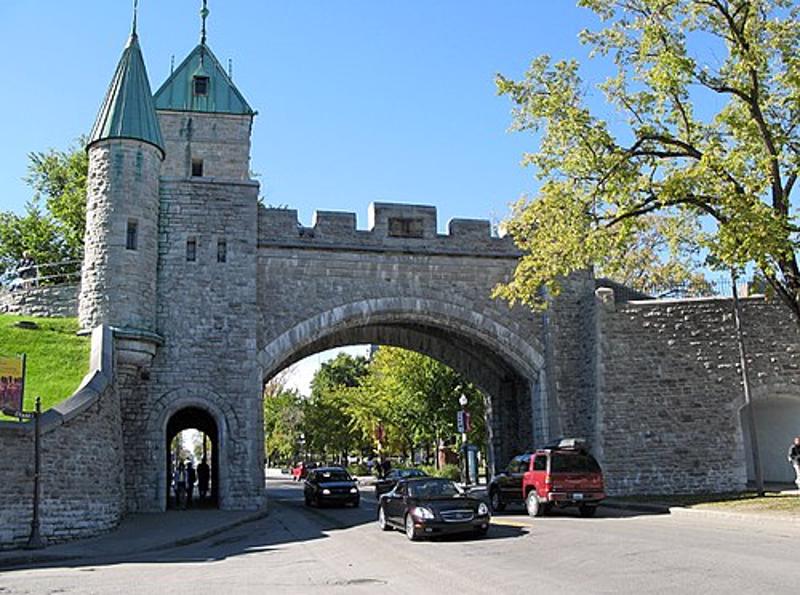
We are staying in Saint Jean Baptise neighbourhood in Quebec City, just west of Old Town. Sandwiched between Old Québec and Montcalm, rue Saint-Jean, the main shopping street, runs through the entire neighbourhood. Over barely 1 km, you can find everything you need. There are a ton of little bistros, bakeries and coffee shops littering the street.
As it turns out we are in a building on the main street and above a bicycle shop (we didn't know that when booking). We are located on the top floor on the back side of the building. It is a quaint one-bedroom apartment with lots of style and retro decor. It is well furnished and well appointed. Lots of space for everyone and very comfortable. So far it is the best pick of our Canadian trip.
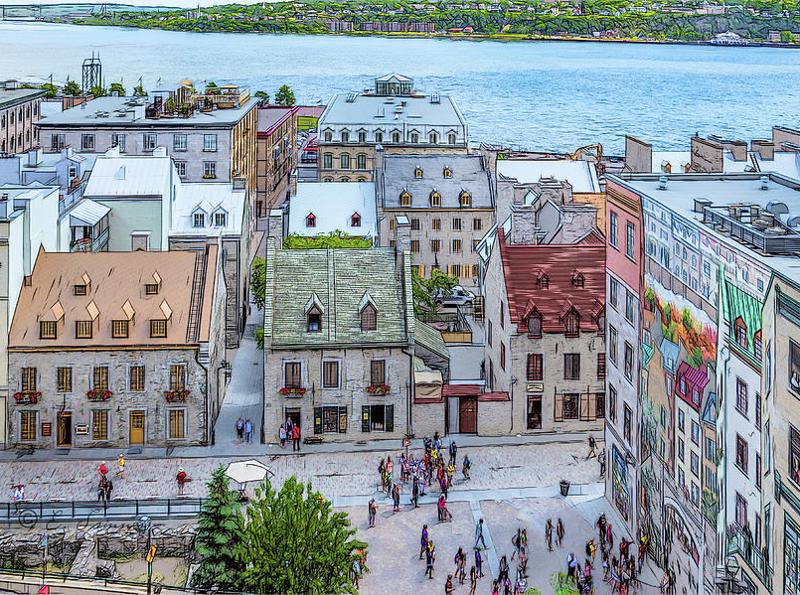
Once we found a place to park we headed out to explore all that Quebec City has to offer. If you head straight down Rue Saint Jean it runs right into Old Quebec City. Old Quebec is a historic neighbourhood of Quebec City, comprising the Upper Town and Lower Town; the area is a UNESCO World Heritage Site.
Samuel de Champlain chose the Upper Town as the site for Fort Saint Louis in 1608. It has remained the city's military and administrative centre because of its strategic position atop the promontory of Cap Diamant. It was occupied mainly by British government officials and Catholic clergy after the British Conquest, while French and English merchants and artisans lived in Lower Town.
The Lower Town is a historic district located at the bottom of Cap
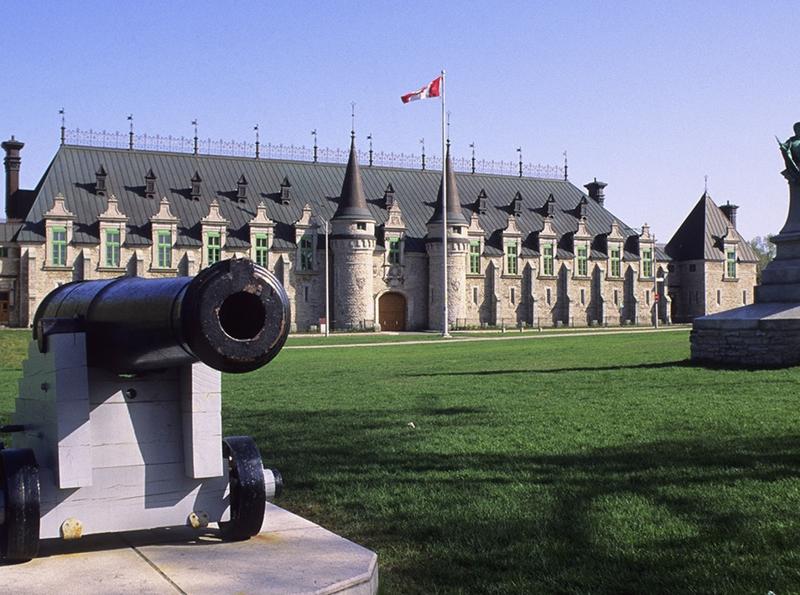
Diamant. During 1608, Samuel de Champlain built a habitation where its remains can be found with Place Royale as its centre. It was restored with the goal of reconstructing the French flair from its origins. Construction of the Church of Notre-Dame-des-Victoires started during 1687 at this location and was completed during 1723. The Musée de la civilisation, the Musée naval de Québec, the caserne Dalhousie and the Théâtre Petit Champlain are among some of the museums, performance halls, theatres and exhibition venues in Lower Town.
A funicular car allows for easy transportation up Cap Diamant connecting to Upper Town from the narrow Petit-Champlain road at the foot of the Cape to the top with a marvellous view of the city. Côte de la Montagne is another option for those who don't mind the hike up steep steps or roadways.
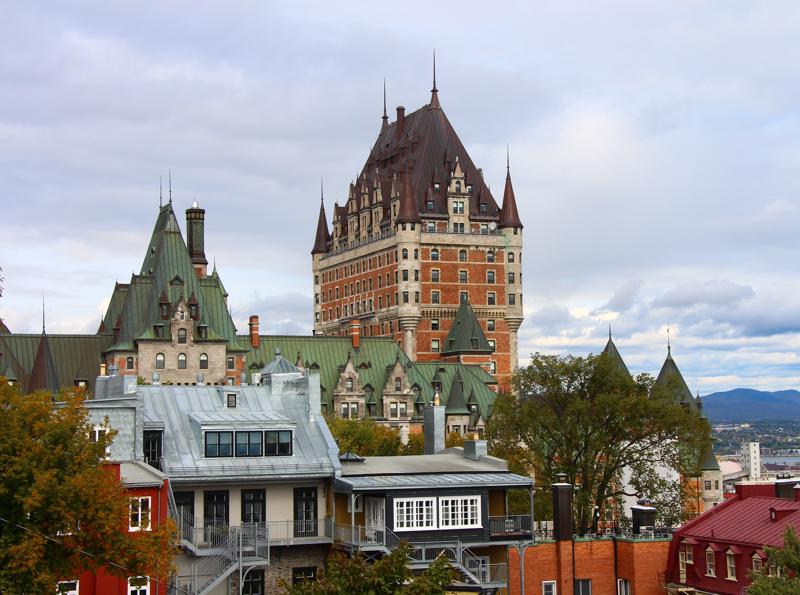


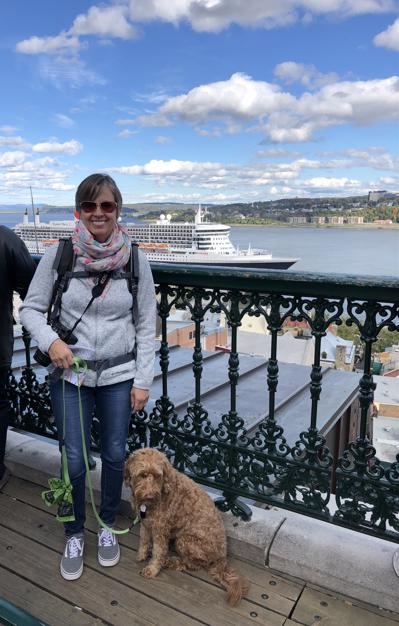
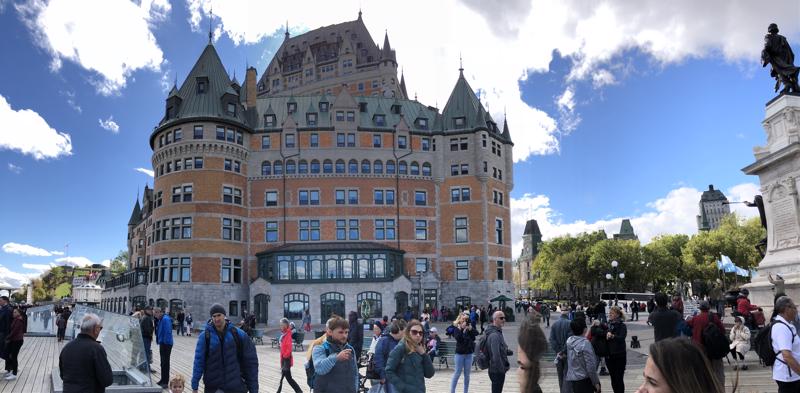
The Ramparts of Quebec City are the only remaining fortified city walls in North America north of Mexico. The British began refortifying the existing walls, after they took Quebec City from the French in the Battle of the Plains of Abraham in 1759.
The wall, which runs on the eastern extremity on the Promontory of Quebec, surrounds most of Old Quebec, which was declared a World Heritage site by UNESCO in 1985. The fortifications were designated a National Historic Site of Canada in 1948. There are only four surviving gates in the ramparts, many which have been rebuilt over the years due to poor condition and breakdown over the years.
The most prominent building in all of Quebec City is the Fairmont Chateau Frontenac. Opened in 1893, the Châteauesque-styled building is 79.9-metre-tall (262 ft), containing 18 floors. The building's height is furthered, as it is situated at an elevation of 54 m (177 ft) above the lower Old Town. It is a spectacular hotel, much like the Chateau Lake Louise.
The Château was the brainchild of William Van Horne, president of the Canadian Pacific Railway, who wanted to build a hotel to draw travellers as a way to promote luxury train travel. Many famous people have made the Château Frontenac their residence during their time
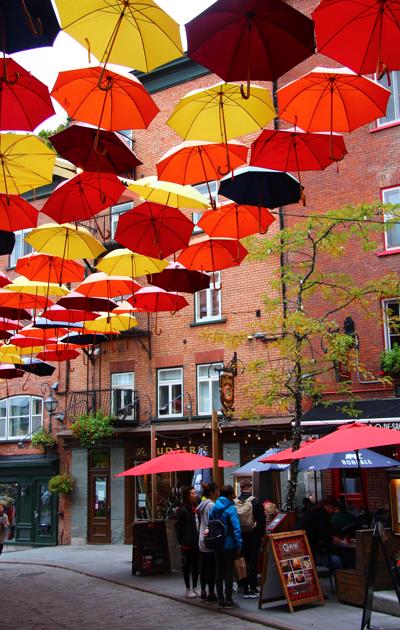
in Québec City. From Queen Elizabeth II to Céline Dion, via Princess Grace of Monaco, Leonardo DiCaprio, Paul McCartney and Charlie Chaplin, celebrities have made the Château Frontenac their home away from home.
After exploring the outer grounds of the Chateau Frontenac we started down the "breakneck staircase" to the Lower Old Quebec City and the Petit Champlain District. The funicular, which has linked Lower Town to the Dufferin Terrace for over a hundred years, offers breathtaking views of the St. Lawrence River. The lower entrance is inside Maison Louis-Jolliet, the one-time residence of the man who discovered the Mississippi River.
Legendary Place Royale is steeped in history. It was here that Samuel de Champlain chose to erect his Abitation, which served as a fort, storehouse, trading post, and residence when he arrived in
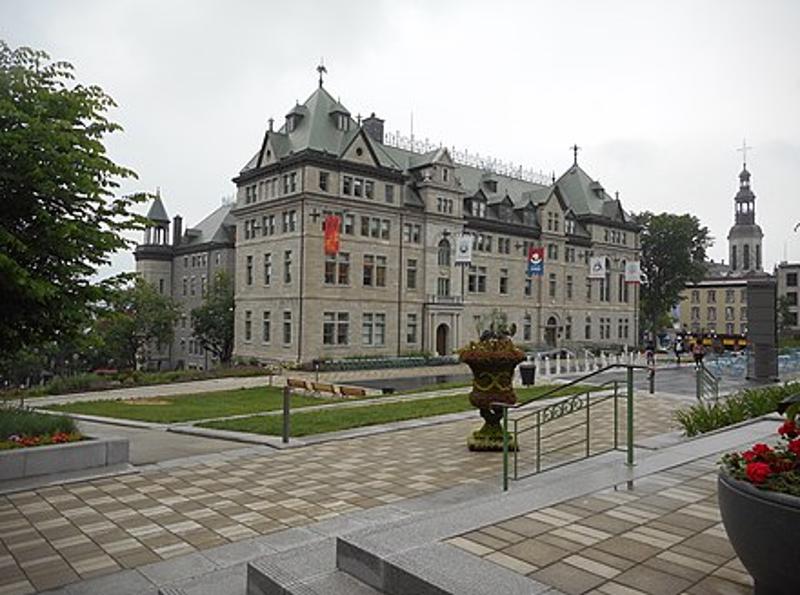


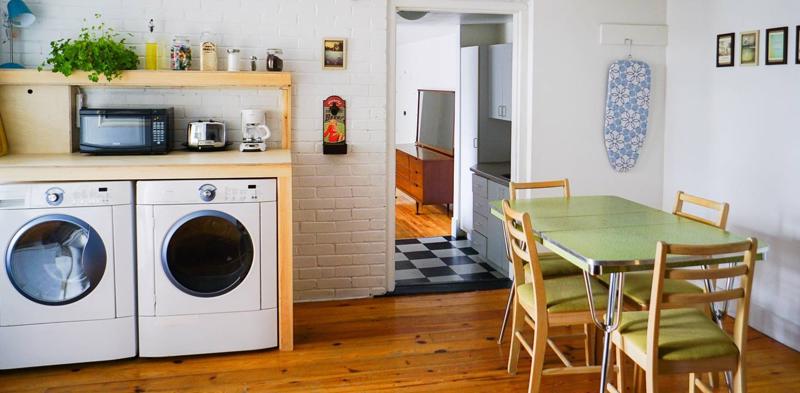
1608. It was the first permanent French settlement in North America. Place Royale is also home to Notre-Dame-des-Victoires, the oldest stone church in North America, built in 1688.
The French influence is evident everywhere you look in Place Royale and along Rue du Petit-Champlain, one of the oldest commercial streets in North America. The two- and three-storey plastered stone homes with their dormer windows, gabled roofs, large chimneys and party walls rising above the rooftops to act as firewalls are all typical of the French architectural style of the time.
On our way home we walked along the lower road of the Lower Old City. As you walk around the old town you can catch glimpses of the wall peeking in between the homes. The streets are lined with antique shops and restaurants. Walking around the lower old town

we headed to the local market - Marche du Vieux Port. Here you’ll find both locals and tourists partaking in cider sampling and, depending on the time of year, enjoying the fresh, in-season produce; wandering through stalls selling different jams, meats, spices, pastries and more. Today it was fairly quiet and not much action between the vendors and people, however, I think that in the summer the market could be really hopping.
After a full day we headed home with Roxy to get checked in to our AirBnB. She joined us for the entire afternoon and loved it when people would make a fuss over her. We decided to have simple night in and order take out. Tomorrow is a new day to discover more what Quebec City has to offer.
Cassoulet Recipe (traditional Duck or Rabbit)
Ingredients
4 cups cooked tarbais or white beans, recipe below
4 cups braising liquids (lamb, chicken, duck or rabbit)
8 1-oz pieces braised lamb
8 oz duck or rabbit confit, medium to large pieces removed from bones
2 4-oz pork sausages in casing, seared and sliced into 4 pieces each
4 slices pancetta, 1/3- to 1/4-inch thick
8 Tablespoons duck fat
8 Tablespoons breadcrumbs
1/2 cup duck or pancetta fat
1 large white onion
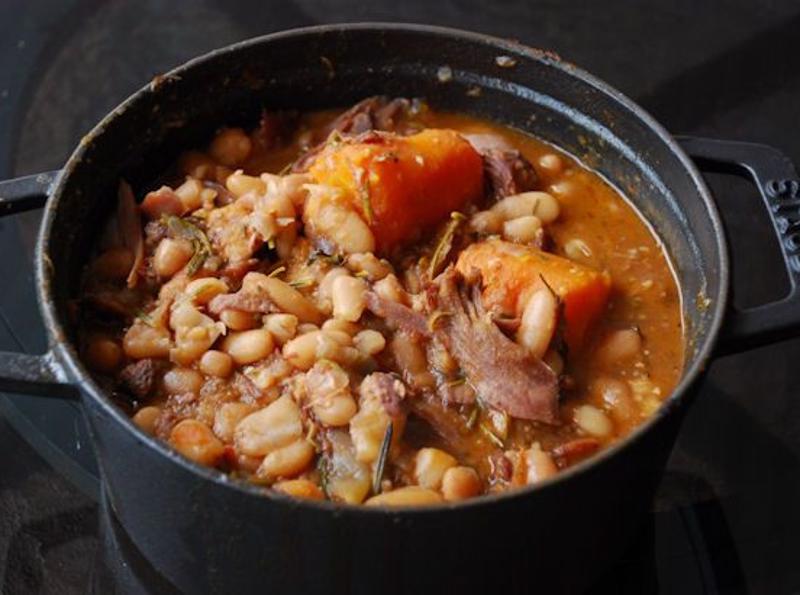
3 garlic cloves, sliced in half
5 sprigs thyme
3 sprigs rosemary
2 bay leaves
Pinch chili flakes
1/2 cup tomato paste
1/2 cup red wine
3/4 quart tarbais or white beans, soaked overnight
Kosher salt, to taste
Directions
Preheat convection oven to 350 degrees F. Place an earthenware dish into the oven to warm.
In a large saute pan combine white beans, liquids, lamb, duck and sausages.
Place the slices of pancetta in another pan and sear until crisp on one side. Bring the meat and bean mixture to a simmer and pour into the hot earthenware dish. Once the pancetta is crisp on one side, place unseared side on top of the bean mixture, leaving crisp side facing upward. Place back into the oven.
Cook until cassoulet is hot and the bean mixture is simmering. The liquid should be reduced but the bean mixture should still be very loose and moist. Remove earthenware dish from the oven. Drizzle duck fat on top and finish with breadcrumbs.
Beans for Cassoulet:
In a large sauce pot warm fat over medium high heat. Add onions, garlic, thyme, rosemary, bay and chili flakes. Cook until onions are soft, then add tomato paste and cook until tomato has caramelized on bottom of pan, 5 to 10 minutes.
Deglaze with red wine and cook until reduce to au sec (nearly dry). Add beans, stir to coat with tomato, add water to cover. Bring to a simmer over medium-high heat, then reduce temperature to keep beans cooking at a gentle simmer. Add water as needed.
Cook until the beans are tender and starch texture becomes creamy, up to 2 hours depending on the beans. Pour into a shallow pan and salt appropriately. Place into refrigerator and cool.
1.
Year of Travel
2.
Sosua - Dominican Republic
3.
Our Adventures So Far...
4.
Beach Life
5.
Our Favourite Restaurants in Sosua
6.
Fun with Friends
7.
Sosua Continued
8.
Sun, Surf and Sand
9.
Samana Peninsula
10.
Sosua Highlights
11.
USA Road Trip
12.
Texas
13.
Texas
14.
Louisiana - NOLA
15.
Louisiana - NOLA
16.
Louisiana - NOLA
17.
Alabama
18.
Alabama to Tennesse
19.
Tennesse - Nashville
20.
Tennesse - Nashville
21.
Tennesse - Nashville
22.
Tennesse - Memphis
23.
Tennesse - Memphis
24.
Tennesse - Memphis
25.
Summer at Home
26.
Westcoast Adventures
27.
Europe
28.
Europe - Budapest
29.
Europe - Budapest
30.
Europe - Vienna
31.
Europe - Vienna
32.
Europe - Vienna
33.
Europe - Prague
34.
Europe - Prague
35.
Europe - Prague
36.
Europe - Berlin
37.
Europe - Berlin
38.
Europe - Berlin
39.
Europe - Salzburg
40.
Europe - Salzburg
41.
Europe - Salzburg
42.
Europe - Salzburg
43.
Europe - Salzburg
44.
Europe - Innsbruck
45.
Europe - Innsbruck
46.
Europe - Bad Ragaz
47.
Europe - Bad Ragaz
48.
Europe - Lindau
49.
Europe - Lindau
50.
Europe - Fussen
51.
Europe - Fussen
52.
Europe - Freising and Munich
53.
San Francisco
54.
San Francisco
55.
San Francisco
56.
San Francisco
57.
San Francisco
58.
San Francisco
59.
Canada Road Trip
60.
On the Road to Ontario
61.
Ontario - Thunderbay
62.
Ontario - Thunderbay
63.
Ontario - Thunderbay
64.
Ontario - Toronto
65.
Ontario - Ottawa
66.
Ontario - Ottawa
67.
Quebec - Montreal
68.
Quebec - Montreal
69.
Quebec - Montreal
70.
Quebec - Quebec City
71.
Quebec - Quebec City
72.
Quebec - Sainte Flavie
73.
New Brunswick - Bathurst
74.
New Brunswick - Shediac
75.
New Brunswick - Shediac
76.
Prince Edward Island - Charlottetown
77.
Prince Edward Island - Road trip
78.
Prince Edward Island - Charlottetown
79.
Prince Edward Island - More exploration
80.
Nova Scotia - Halifax
81.
Nova Scotia - Halifax
82.
Nova Scotia - Halifax
83.
Nova Scotia - Sydney
84.
Newfoundland - Channel-Port
85.
Newfoundland - Rocky Harbour
86.
Newfoundland - Rocky Harbour
87.
Newfoundland - St. John's
88.
Newfoundland - St. John's
89.
Newfoundland - St. John's
90.
Newfoundland - St. John's
91.
Newfoundland - St. John's
92.
Newfoundland - Travelling
93.
Nova Scotia - Sydney
94.
New Brunswick - Saint John
95.
Maine - Portland
96.
Massachessets - Cape Cod via Boston
97.
Massachusetts - Cape Cod
98.
Massachusetts - Cape Cod
99.
Pennsylvania - Clearfield
100.
Illinois - Chicago
101.
Illinois - Chicago
102.
Illinois - Chicago
103.
Heading Home
104.
Our Year at a Glance
Share your travel adventures like this!
Create your own travel blog in one step
Share with friends and family to follow your journey
Easy set up, no technical knowledge needed and unlimited storage!
© 2025 Travel Diaries. All rights reserved.